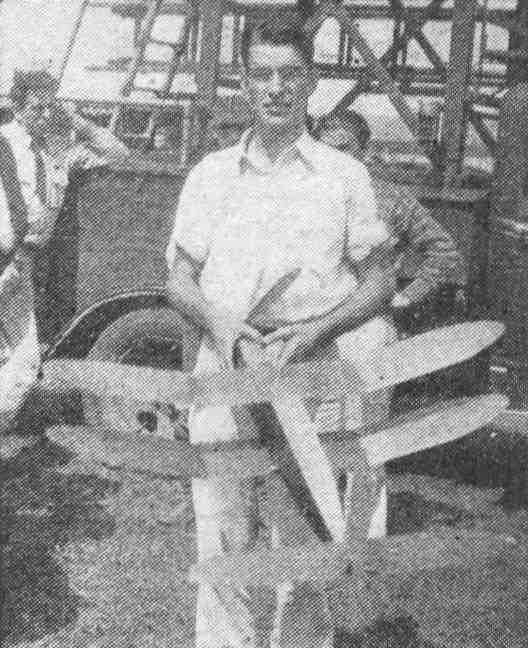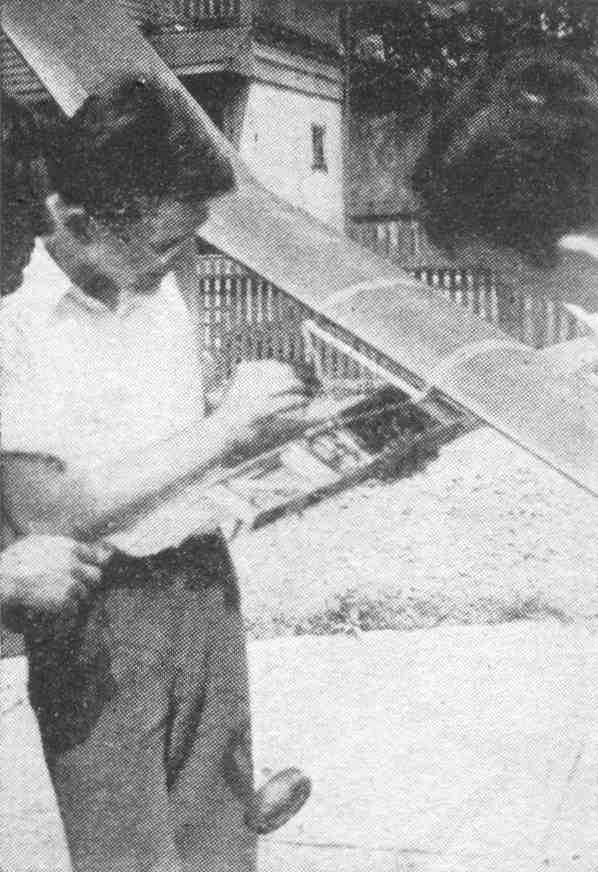|
The DUPLEX
Complete plans for building a championship
model that holds two world's records -- fuselage
and stick
By Chester Lanzo
in collaboration with
Gordon S. Light
|

Chester Lanzo holding the Duplex, here equipped with experimental
biplane wings. |
ABOUT CHESTER LANZO
Chester D. Lanzo has been building models for the
past twelve years. He lives in Cleveland, Ohio, and his work and
enthusiasm has done much to stimulate model interest in that city.
He's the leader of the group of Cleveland experts who prove a
worthwhile threat at any contest.
During the past year he's held two world records:
outdoor fuselage and outdoor stick. The ship he used in making these
records is the one described in this issue. His trophy case contains
seven trophies, along with numerous medals and other prizes.
Outstanding is the Major Al Williams Trophy, valued at five hundred
dollars and won at the National Meet of the Junior Aviators of
America.
Lanzo has done considerable acrobatic and stunt
model flying. Smoke screens, parachute drops, and stunt flying are a
few of the tricks his carefully adjusted models will perform. |

Lanzo, shown adjusting a stick-gas model, is adept in all phases of
model construction. |
Chester LANZO'S models always turn in a good contest
performance. But the Duplex is probably the most outstanding of all his
contest designs. The Duplex holds 2 records. At a contest last year it was
officially timed at 48 minutes and 45 seconds, one of the longest official
flights ever turned in by a rubber-powered model. For the past year this
model has held the National Aeronautic Association record for cabin
fuselage models. Since Lanzo is over 21, leis record is catalogued as an
Open Class Record to distinguished it from the Junior and Senior records
turned in by modelers younger than 21 years.
Lanzo proved his modeling superiority by converting
this same model into a hand-launched stick model and flying it for another
official record. It was a flight of 18 minutes and 10 seconds. The only
change Lanzo made in his model was to substitute a slightly different
fuselage. In the hand-launched stick-model event, no landing gear is
required, as the models are hand-launched. And, too, there is no
restriction on cross-section area. So the "stick" fuselage is slightly
shorter and considerably "thinner" than the cabin fuselage. In all
respects the 2 fuselages seem very much alike. The stick fuselage is built
up and carries the motor internally, just the same as the cabin fuselage.
This is a more convenient way of distributing the strain of the powerful
motor than suspending it from a single stick, as was done in the old-type
models.
Both fuselages are built to fit the same nose and tail
plugs. The wing is easily transferred from one to the other. The change
from cabin-fuselage model to stick model is accomplished in a few seconds.
Two-in-one is the best way to describe this model. By building one model,
plus an additional fuselage, you'll have the benefit of two outstanding
championship models. It's an inexpensive and convenient short cut in
building up your quota of contest ships. Or, if you're a beginner, the
Duplex should be an ideal way to acquaint yourself with the different
types of contest models.
The Duplex was designed to conform to last year's
weight requirements of 1 ounce per 50 square inches. Therefore, it will be
necessary to increase the weight about 2 ounces to bring it up to this
year's weight rules. Lanzo suggests the following changes to meet the
weight rule of 3 ounces per 100 square inches: a slight decrease in
elevator area of approximately 5 percent; a decrease in propeller area and
a decrease in diameter to 17 inches; larger nose and rear plug to
facilitate winding with increased amount of rubber motor; a more
substantial landing gear to take care of the increased weight of the
model; closer rib spacing in the wing and tail, and closer spacing between
fuselage uprights; and an increase in power to about 30-35 strands of 1/8"
flat rubber.
The details of these changes are left to your own
judgment. The plans as shown here are for the original model as it was
flown by Lanzo.
CABIN FUSELAGE
First we'll describe the construction of the cabin
fuselage. It's more difficult to build than the stick fuselage. 5/64" sq.
hard balsa longerons are used. If you're planning to increase the weight
of the model, substitute 3/32" sq. hard balsa longerons. The sketch of the
fuselage is fully dimensioned and you should have little trouble in making
a full-size layout on a piece of drawing paper. First draw the thrust line
of the model and dimension all parts of the fuselage with reference to
this line, as has been done on the sketch.
Both the rear tip of the fuselage and the nose block
are demountable for access to the rubber motor. The nose block is cut from
a balsa block 3/8 x 1-5/8 x 1-1/16". Metal plates are cemented to both
front and rear of the nosing. The front plate serves as a bearing for the
propeller and the rear plate is raised about 1/16" above the front plate
to give the propeller 2 degrees of negative or downthrust. No right or
left thrust is used. The nosing is secured to the front of the fuselage by
a rubber band, which fits into a notch in the top of the nosing and
extends down underneath the bottom of the fuselage. Wire hooks are
cemented to the fuselage at the bottom of the second upright to receive
the rubber bands.
The rear tip of the fuselage (2-1/2" from the rear) is
removable. Build the fuselage in one piece and cut away the rear tip after
construction is completed. The rear hook is bent from 1/16" diameter wire
and secured to the rear boom. When flying, the boom is attached to the
fuselage with a few drops of cement applied immediately after winding has
been completed. The tension of the rubber motor will hold the boom in
place. By the time the motor has unwound the cement will have dried and
will be capable of holding the boom in position. After the flight the boom
call be removed by inserting a knife or razor blade.
LANDING GEAR
A single-strut landing gear is made from, bamboo. The
corners of the bamboo struts are rounded with sandpaper and the strut is
tapered from 1/16 x 3/16" to. 1/16 x 1/16" at the wheel end. The struts
extend the full depth of the fuselage, the ends being joined to the cross
brace at the front of the cabin window. This cross brace is strengthened
by an auxiliary block of hard balsa 1/16 x 3/4 x 2-1/2" cemented flush to
the top surface of the fuselage. The struts are also threaded and cemented
to the bottom longerons. The wheels are 2 inches is diameter and are built
up of 2 thicknesses of 1/8" balsa cemented cross grain.
WING
The wing is built in 3 sections. Each of these sections
is completed --- built, covered and doped --- and then they are joined
together to make the complete wing. The two tip sections are cemented to
the ends of the center section, which is flat. Take care to make a snug
joint between the tip and the center section. During the early stages of
construction make certain the first rib of the tip section is staggered,
so it will fit flush against the end rib of the center section to make a
nice snug cement joint. It will be necessary to raise the tip section 5"
(the necessary dihedral) when determining the correct angle for these
ribs.
Notice how the forward spars of the wing curve backward
at the tips of the wing. This makes the wing tip easier to cover and
prevents the tissue from sagging. There is no set procedure for bending
the spars to this shape. Merely force them into position following the
shape drawn in the sketch of the wing.
ELEVATOR AND RUDDER
In the construction of the tail surfaces, Lanzo should
certainly prove to be a favorite designer for many modelers. He used a
lift section in the elevator and this same rib shape for the rudder. This
makes it possible to use the same airfoil template for both rudder and
elevator ribs.
Construction of the elevator and rudder is similar. The
size of material is identical in both cases. The dimensions of the tail
surfaces are available from the sketches.
PROPELLER
The large 18" propeller turned by an ample rubber motor
is the secret of the modelís long duration and steep, fast climb. The
propeller block is medium - grade balsa. The method of laying off the
block is illustrated. The free -wheeler device is made from 1/16" sheet
brass. The shape of the metal plates is shown full-size in the drawing.
They are cemented and threaded to both faces of the propeller hub. 1/16"
diameter wire is used for the propeller shaft. A loop is bent in the front
of the shaft, after it has been inserted through the propeller. This loop
fits onto the winder.
ASSEMBLY
The rudder is cemented atop the stabilizer at zero
degrees. That is, the flat under-surface of the rudder should be lined up
with the center rib of the elevator. The elevator is cemented flat to the
top of the rear boom of the fuselage. The bottom of the rudder is cemented
to the extreme rear tip of the boom.
The wing is mounted flat atop the fuselage, using
rubber bands for attachment. A 7/32" incidence block is inserted, as shown
between the bottom of the wing and top of the fuselage. The original model
weighed 4.1 ounces ready to fly.
FLYING
The power was 24 strands of Banko's Superlastic, 1/8"
flat, gray rubber. The motor was 40" long and was soaked in lubricant for
one day prior to the contest. It is wound by hooking the propeller shaft
on the winder and stretching the motor out through the nosing of the
model. The boom is removed from the fuselage and the other end of the
motor is held at the rear hook fitting.
The model flies against the torque in large circles. It
should be adjusted to dip slightly when changing from powered to gliding
flight. The durations turned in by the model show its ability to glide and
take advantage of favorable currents.
BUILDING THE STICK-MODEL FUSELAGE
The stick-model fuselage is smaller than the cabin
fuselage. The landing gear and the cabin are omitted. Special care should
be taken when building this fuselage to make sure the front and rear ends
will fit the nosing anal tail boom which you've already built for the
cabin fuselage.
Construction follows that of the cabin fuselage. The
few differences are pointed out on the drawing. The nosing and the tail
boom are mounted in the same way.
Flying the model with the stick fuselage is practically
the same as with the cabin fuselage. It will be necessary to move the wing
back a trifle to compensate for the eliminated weight of the landing gear.
The incidence of the wing is reduced to 1/8".
Scanned from September, 1937
Air Trails





 |